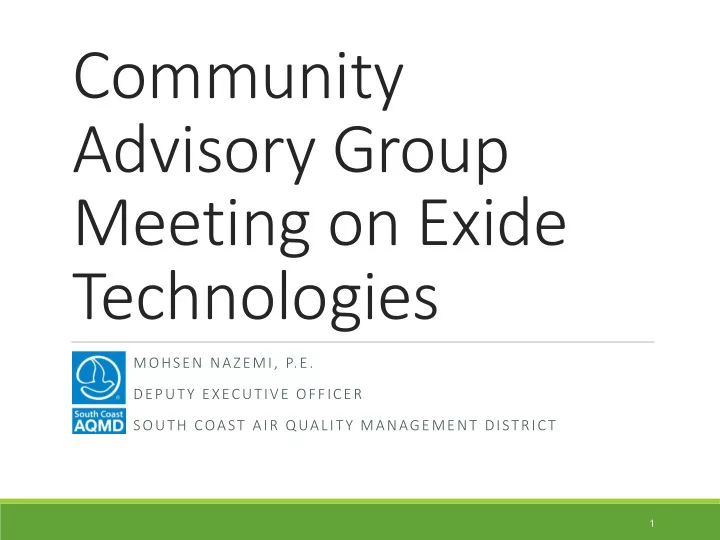

Community Advisory Group Meeting on Exide Technologies MOHSEN NAZEMI, P.E. DEPUTY EXECUTIVE OFFICER SOUTH COAST AIR QUALITY MANAGEMENT DISTRICT 1
SCAQMD Concerns on Exide’s Closure Plan Demolition of Total Enclosure buildings and roof panels ◦ Decontamination and removal of walls and roof panels of Total Enclosures shall be performed in areas under negative pressure with properly operating air pollution control equipment and ducting until demolition is completed. ◦ A windbreak shall be constructed on outside walls and roof panels by securing plastic sheeting on scaffolding and structural elements to control fugitive emissions. ◦ Plastic sheeting and other materials shall be thoroughly washed and placed in containment for proper transport and disposal off site. Onsite portable crushing of demolition debris NOT allowed. Exide shall submit VOC Contaminated Rule 1166 mitigation plan if excavation of VOC- contaminated soil is proposed. Exide must comply with all applicable rules and regulations, permit conditions, and Order for Abatement requirements at all times. Exide shall submit for SCAQMD approval a transportation plan to address offsite transport of lead and lead-containing materials. 2
Proposed Removal of Lead Kettles Proposals for removal of 13 kettles are based on amount of lead per kettle ◦ 6 kettles containing less than12 tons of lead ◦ Can be removed by overhead crane without removing their contents ◦ 7 kettles containing 12-100 tons of lead ◦ Cannot be removed by overhead crane without reducing amount of lead in kettles ◦ Lifting capacity of overhead crane less than 15 tons ◦ Floor of total enclosure cannot support combined weight of crane and lead in kettles ◦ Options for lead removal ◦ Cutting lead into smaller chunks using high-pressure water or air cutting, or jackhammer; extracting chunks, then removing kettle with residual lead by overhead crane ◦ Melting kettle contents, pouring excess into movable container until the weight of kettle and lead is < 12 tons, then removing kettle with residual lead by overhead crane ◦ Requires negative pressure monitor to ensure emissions from molten lead are captured by hoods 3
Key Rules for Control of Metal Emissions – Rule 1420 Rule 1420 adopted in 1992 for all Lead processing facilities Required ambient monitoring of lead (1.5 µg/m 3 ) Required control equipment for all lead sources to achieve minimum 98% removal efficiency Required housekeeping measures to prevent fugitive lead dust emissions 4
Key Rules for Control of Metal Emissions – Rule 1407 Rule 1407 adopted in 1994 for all metal melting facilities Called for the reduction of emissions of arsenic, cadmium, and nickel Required control equipment for all emission points to achieve minimum 99% removal efficiency Required maintenance & housekeeping measures to prevent fugitive emissions 5
Key Rules for Secondary Lead Smelters – Rule 1420.1 Rule 1420.1 adopted in 2010 specifically for secondary lead smelters melting facilities Required Total Enclosures for all lead handling areas of facility (more stringent than the Federal requirement of Total or Partial Enclosures) Required control devices for all lead point sources with a facility-wide control of lead not to exceed .045 lbs per hour (in general, more stringent than the Federal equivalent standard of 2 mg/dscm) 6
Key Rules for Secondary Lead Smelters – Rule 1420.1 (cont’d) Required ambient monitoring for lead (no Federal requirement for ambient monitoring) Required ambient concentration of lead not to exceed 0.15 µg/m 3 on a 30-day average and one in 3 days monitoring (more stringent than Federal standard based on a 90-day average and one in 6 days monitoring) Required submittal of Compliance Plan for further mitigation measures/emission reductions if ambient lead concentrations exceed 0.12 µg/m 3 (no such Federal requirement) 7
Key Rules for Secondary Lead Smelters – Rule 1420.1 (cont’d) Rule 1420.1 amended in 2014 Established hourly emission limits for carcinogens arsenic, benzene, & 1- 3, butadiene (no such limits required Federally) Required ambient air monitoring for arsenic (not required in Federal regulation) Arsenic concentration set at 10 ng/m 3 (no such Federal standard) Production curtailment required if facility exceeds ambient limits for lead or arsenic (no Federal requirement) Require demonstration project to continuously monitor & measure stack emissions of lead and arsenic (no Federal requirement) 8
Key Rules for Secondary Lead Smelters – Rule 1420.1 (cont’d) Rule 1420.1 again amended in 2015 Lowered hourly emission limit for lead by 50% (from .045 to .023 lbs/hr (in general, more stringent than the Federal equivalent standard of 1 mg/dscm) Lowered 30-day averaged ambient air limit for lead to 0.110 µg/m 3 by 2016 and to 0.100 µg/m 3 by 2017 and daily monitoring (Federal standard remains at 0.15 µg/m 3 averaged over 90 days and one in 6 days monitoring) Daily sampling required as opposed to every three days & provisions added for monitor failure (no such Federal requirements) Requires submittal of Compliance Plan for further mitigation measures/emission reductions if ambient lead concentrations exceed 0.11 or 0.10 µg/m 3 , as applicable (no such Federal requirement) Includes plant closure requirements that include a Closure Plan and continued ambient air monitoring for lead and arsenic. 9
Recommend
More recommend